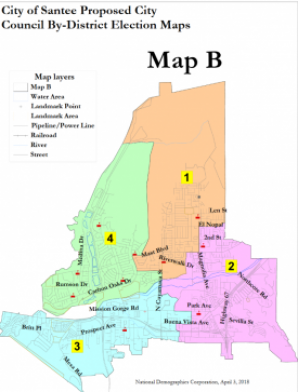
By Mike Allen
View full-size map B adopted by Council here.
April 14, 2018 (Santee) -- Santee’s ongoing process of shifting from voting for their representatives by all city voters to a system of district elections took another step to reality last week when the council adopted a map made by Mayor John Minto and held the first reading instituting the change.
Minto offered a map he drew that divides the city into four areas and with a close balance of some 13,000 people in each district. His motion also called for a change in the cycle of elections that results in two council seats being elected every four years starting in 2020. The mayor’s position will remain at large, or selected by all city voters.
His motion, which was seconded by Councilman Ronn Hall, passed 3-2 with Council members Brian Jones and Rob McNelis opposed. The second reading and adoption of the law and the map is scheduled for April 25.
Minto called his submission “the most fair map” and one that didn’t favor any of three of the four announced candidates, who Minto said are personal friends of his.
“My attempt was to make the most fair map,” he said. “We’re going to give everybody that fair chance that they should have.”
Jones attempted to put a substitute motion in play but withdrew it to allow for a vote on Minto’s motion. He was advocating on behalf of adopting Map A which the council initially approved at its March 28 meeting. The council noted that map was tentative, and could be changed. They asked citizens to submit their own maps.
Map A was criticized by several speakers as biased and unethical because it was submitted by Dustin Trotter, an announced candidate who is seeking to run this year. Trotter came in second place in the 2016 election.
Under the Map B adopted last week, Trotter resides in District 4, which won't be up for re-election for two years. The seat is now held by Councilman Stephen Houlahan, who also resides in District 4.
The new system calls for two districts to be up for election every four years, starting in 2020. Districts 1 and 2 would elect a representative this year for four-year terms. The District 3 representative up for election this November will have a two-year term, and then run again for a four-year term starting in 2020.
None of Santee’s elected officials said they liked any of the maps provided by the hired consultant, National Demographics Corp. The selected map generally divides the city in four quadrants following Cuyamaca Street and Fanita Drive on the north/ south axis, and the San Diego River on the east/west axis.
Santee embarked on changing to district elections starting in January after it was notified that it wasn’t in compliance with the California Voting Rights Act that requires all cities to hold district elections.
The law was enacted to protect minority populations from being excluded on public boards. But Santee council members unanimously ripped the law saying it was unnecessary because minority populations are spread evenly in the city, and that it would reduce community cooperation.
However, they also said challenging the law was pointless because no city in the state had been successful in such challenges, and it would cost hefty legal fees the city can’t afford.
Several Santee residents said they were opposed to the council’s initial Map A because it was a blatant attempt by one candidate, Trotter, to carve out a favorable district for himself.
“I strongly object to any district map submitted by the public,” said Janet Garvin, who advocated selecting a map submitted by the unbiased consultants. “Anything else has to be considered as highly unethical, and nothing more than a political power grab.”
But Minto and others said Trotter was smart and within his rights to create a map that gave him an edge, and that there was nothing unethical about his effort.
No matter what map was selected, it would contain some bias, said several council members.
Several council members decried the process of going to district elections as divisive and would ruin the generally cooperative spirit that now exists within the city.
Hall said with the change, council members would be less apt to work on issues that did not affect their own district. In San Diego, which has had district elections for decades, council members are focused only on what happens in their districts and generally don’t care what happens outside those boundaries, Hall said.
Jones said the conflict about the boundary lines was indicative of what will likely occur in the future due to the new district system. “We have one of the best cities in the county, one of the best in the state….Now we’re going to our own corners of the ring and coming out boxing.”
The change to district elections will directly impact at least four men who have taken out nominating papers so far for possible inclusion on the November ballot. They are Zack Gianino, Rob Koch, Bob Lloyd and James Sly.
Three council seats are up for election this year. Those held by McNelis, Hall, and Jones, who was appointed in 2017 to fill out the remainder of Minto’s term when he was elected mayor in 2016.
Jones has said he is running for the state Senate seat now held by Joel Anderson, who will be termed out this year and is supposedly aiming to replace outgoing Supervisor Dianne Jacob.







Recent comments